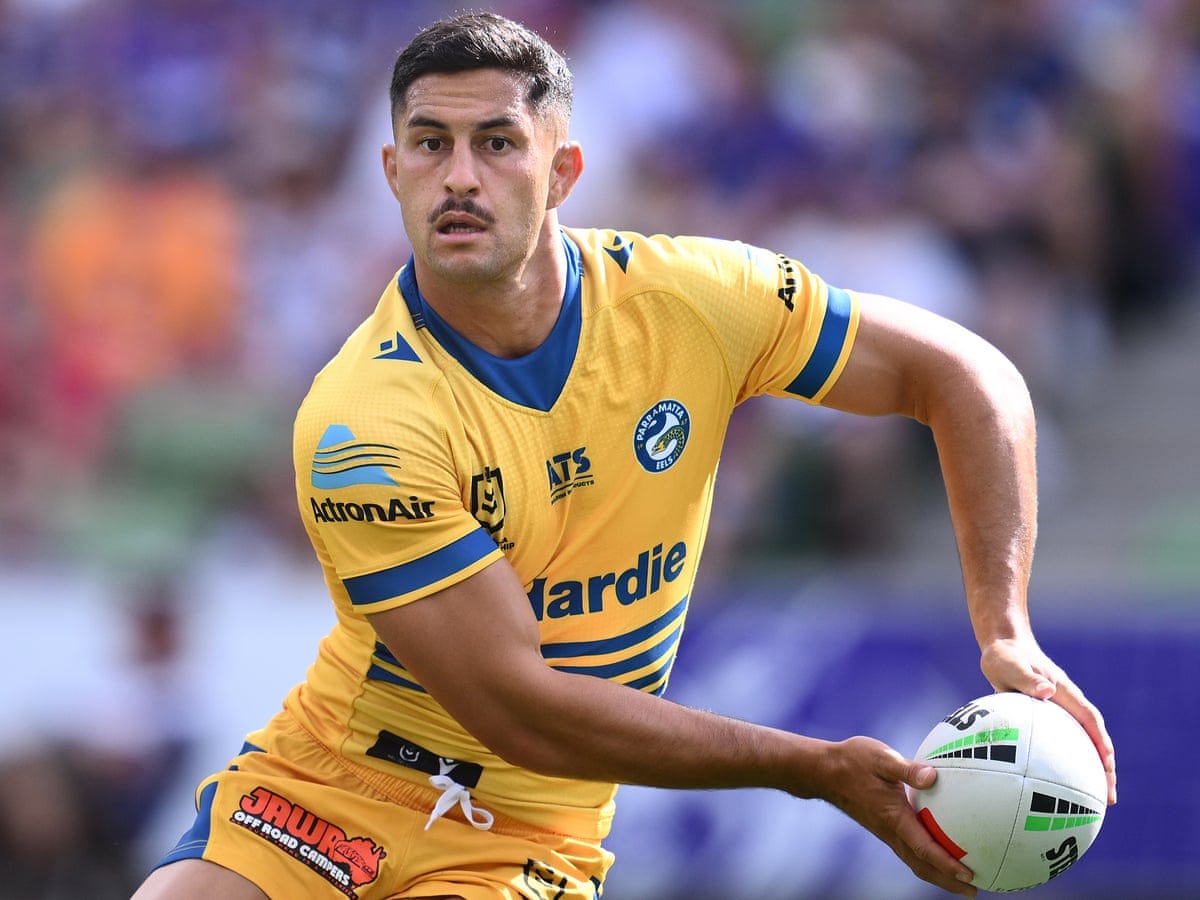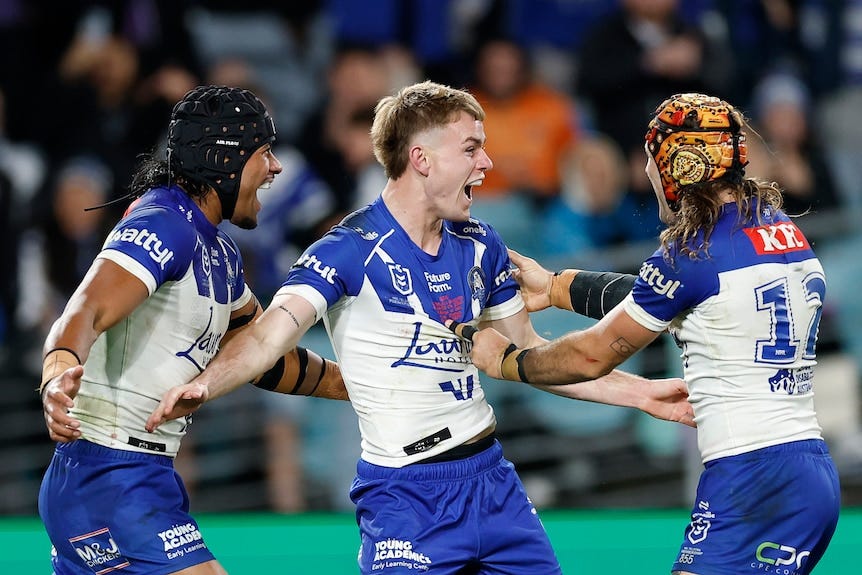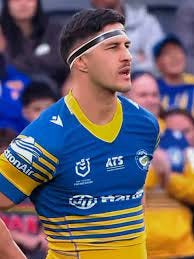Change is circular
The case study of chopping halves at the bottom and the top
Why change a winning formula?
That’s the question that was lobbed at Canterbury earlier this season during the carousel of playmaking perpetuity, where Lachlan Galvin said some very not-nice things about the Wests Tigers before jumping ship to Belmore.
I’m not going to rehash my thoughts on how Galvin, the Tigers or his management handled the breakup at the time because it was frankly unbecoming that it dragged out as long as it did (with a little help from the kindling that is the media), but if you do want to hit yourself over the head again and relive that saga, read below.
Anyway, to the Dogs, Galvin coming in threw the proverbial cat among the pigeons, as the initially scatterbrained approach of Cameron Ciraldo led to bench utility Galvin, half-turned-hooker Toby Sexton, and the benching of Reed Mahoney.
Changing two spine positions halfway through a game is a strategy fraught with risk at the best of times, even before accounting for the Bulldogs’ propensity to sputter through games at time from an attacking point of view, maybe their closest mirror to the Penrith dynasty they so keenly and openly try to emulate. Penrith get criticised for their attacking futility at times, but the blunt force trauma is all part of the plan.
Penrith get away with it now because *gestures at the last four years*, the Bulldogs don’t…yet.
The Bulldogs own a 6-4 record in the Galvin Era so far, the first game of which was a softball against a sputtering Parramatta side before surviving a fast-finishing South Sydney in Galvin’s first start with Matt Burton missing.
The following two games were what got the knives sharpening, an 8-6 loss to Penrith branded as “game of the season” and “of a finals intensity”, followed by choking away a 16-0 halftime lead to lose to the Brisbane Broncos, who themselves still aren’t really sure what they are (I started writing this piece two weeks ago, before the Mam and Reynolds injuries, so keep that in mind).
The criticisms of the Bulldogs during that stretch were, in my opinion, fair, because they were willingly tying one hand behind their back with the constant merry-go-round between Galvin, Sexton and Mahoney. A decision needed to be made one way or the other between Galvin and Sexton, and live with the consequences.
Toby Sexton has had a really nice year for the Bulldogs, and it’s a snapshot into the cruel nature of the NRL that the halfback of a side firmly entrenched in the top two was cast aside through no fault of his own for the opportunity cost of acquiring one of the brightest prospects in recent memory.
A person’s opinion on Galvin as a prospect goes a long way to determining how they analyse how this situation is playing out, and the value of prioritising long-term development and futureproofing the club over a single fleeting moment in the sun. By that same token, flipping Sexton to the south of France for Galvin might be a lateral or even backwards step as the rest of this season plays out, but it’s pretty clear this move isn’t intended to raise the floor of this team as currently constructed, but rather to smash through the ceiling in the next 5-10 years.
Development isn’t linear and there’s no guarantee that betting on Galvin to the extent that you’d effectively be turning the remainder of this season as a trial run when you’re top four with very real premiership hopes in the hopes of elevating in years to come will prove to be a winning strategy. However, as morose as the Bulldogs now look with ball in hand, their defence is still one of the best in the league, and defensive habits are repeatable, while offensive futility is far easier to work on. You can’t make people want to tackle.
With the benefit of a preseason and settled spine with Mahoney also moving on, the premature integration of Galvin into the Bulldogs may prove indeed to be a recruitment boon.
At the other end of the table, there’s been a similar element of shuffling the deck chairs at Parramatta with Dylan Brown first dropped to create opportunity for long term prospect Joash Papalii, then puzzlingly reintegrated into the squad at centre.
Brown is obviously Newcastle-bound in 2026 on a contract and decision I wrote about previously. Brown reportedly had the chance to leave early before deciding to stay and see the season out.
Whatever you think of the Brown deal from Newcastle’s point of view is largely irrelevant now, but it did create the always fascinating subplot of how a club treats a player who isn’t part of the future (thanks to the NRL’s brilliant player movement system).
There’s always an argument that the player on the way out should be, blacklisted is probably too strong a term, but effectively phased out of the squad to take a look at players who may be there long term (hence the Papalii reference above). That’s a position I usually default to being against only because I saw it firsthand with Matt Burton and Penrith in 2021.
When Burton signed for the Bulldogs there were immediate calls for Penrith to release him early, both for the good of his development and the harmony of the squad. Burton obviously wasn’t released and ended up becoming a premiership winning centre, scoring a try in the Grand Final before departing for Belmore.
Now, the situations between 2021 Penrith and 2025 Parramatta are vastly different, and it doesn’t take someone with an online Harvard degree to figure that out, but it has made me soften on the stance of “pick your best 17 regardless” in the face of a player leaving.
When the decision was made to stop playing Brown in first grade (starting with him playing at hooker in Round 19 against Penrith), Parramatta were anchored to the bottom of the table with no prospect of playing finals footy. In that situation, turning the rest of the season into a glorified preseason and accelerating some development in the process is probably the right move.
Whether you think Joash Papalii is a genuine prospect in the halves is a different issue entirely, and I do appreciate how all these young gun outside backs coming through are all magically halves shoehorned out of position (Jaxon Purdue springs to mind). However, taking the lumps now when the games aren’t as high leverage (Mitchell Moses spray aside) is far better than getting to Round 1 next season and having an “oh shit moment”.
Just quietly too, there’s a lot to like about Parramatta’s spine moving forward with Isaiah Iongi, Mitchell Moses and Ryley Smith, even with the question marks about Papalii at six and whether signing Tallyn Da Silva to a long-term deal after Smith’s breakout season was astute roster management.
Rugby league is a circular game, as evidenced by a top four side and bottom four side masquerading as cheap facsimiles of each other, doing the awkward dance of “which halves pairing will we pick this week?”
The Bulldogs provide the more interesting case study, and it’s fair to wonder if they have indeed submarined any potential chance of a premiership this year by deciding on drastic personnel change midway through the season, but betting on raw talent is always a side of history I’d rather be on over remaining comfortable with a workman.
The way Galvin left the Tigers and the Bulldogs immediate stumbling with him in the side has also done nothing but help grow the legend of Toby Sexton, who again, had a fine season, but the rewriting of history with him as the centrepiece of the renaissance is fanciful and ultimately disingenuous.






